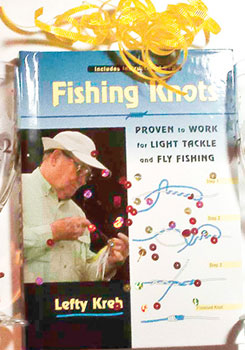New Year's resolutions: Baby steps
From the December 29, 2010 Issue
SUN PHOTO/RUSTY CHINNIS
A good place to start learning knot-tying is Florida
fishing legend Lefty Kreh's book "Fishing Knots."
I seldom make New Year's resolutions and when I do I almost never keep them. I think the problem has been breaking resolutions down into manageable bites. When I thought about it I realized that there are a few simple things that every angler can improve on that will make a big difference when he/she is out on the water. Below are a list of things you can do on a cold and windy day when you can't go fishing. I guarantee you they will pay dividends when you're back in the game.
1. Learn to tie knots properly
You may be able to tie lots of knots, but if you don't tie them properly, the best knot will not be very good. Knots are rated by percent and many knots that anglers tie test out from 80 to 90 percent. The real test of a knot is how well it's tied. The main cause of knot failure is slippage.
Knots, even the so called one hundred percent knots, are susceptible to breaking if they slip. The key to a well tied knot is to have all wraps carefully placed in line and then moistened and carefully set with pliers. Having a hook eye on your tying bench or attached at a convenient place on your boat's consul will pay dividends.
There are lots of online tying videos, books and even an iPhone app that are available as learning resources. The best place to practice is at home, not on the water.
2. Practice sharpening hooks
More fish are lost to dull hooks than any other reason. A sharp hook may seem like a no-brainer but it's surprising how many good anglers don't check hook sharpness. It's important to have hooks sharp when you start fishing, and just as important to check them during your fishing day. A hook hone should be kept within arm's reach at all times.
There are many hooks on the market that are mechanically and chemically sharpened that are very sharp right out of the package. These brands may be extremely sharp, but are hard or impossible to re-point should they get dull.
My preference is a good hook that I can sharpen to my own preference. I test the point on my nail, but this should be done sparingly and carefully as it can compromise the hook's sharpness.
The best hook hones for saltwater are ceramic and will not rust. I carry one on a lanyard around my neck. If you live bait fish the only hook to use is a circle hook. It has an excellent hook-up ratio and is rarely swallowed by a fish, making it easy to release undersized or unwanted fish.
3. Learn how to photograph your catch.
If you understand a few photographic basics and plan a bit in advance, you can bring back shots on your camera's memory card that will last a lifetime. They're also great to share with guests and kids.
Before you leave the dock, make sure you have fresh batteries, memory cards (digital film) and a clean lens. There is almost always a certain amount of chaos associated with catching a memorable fish, so get an idea in advance of where you might take your shot.
Check the background through the view finder carefully for distractions like a rod appearing to stick out of someone's head. If you are prepared, you'll get photographs that aren't posed with the vibrant colors of a fish fresh out of the water.
Fill the frame with the subject, eliminating anything that doesn't add to the composition. Since you're filming on the water, check that the horizon is straight. Make sure you expose your shots with fill flash.
Modern digital cameras, even the less expensive ones, can automatically determine the correct amount of light to fill in the shadows.
Make sure you have the camera set to flash as the auto flash function can't determine when you actually need fill flash. Take a number of shots from different positions and get the angler excited and talking to you.
One of the really great advantages of digital is that you can take lots of pictures and edit them as you go to make sure you have the shot you want.
Take a few minutes this winter to practice these three resolutions and you'll look back and smile this spring when yaou're getting a picture of a prize fish that was caught, photographed and released because you resolved in January to tie better knots, sharpen your hooks and take great shots of that special fish.
Call it the baby step approach to New Year's resolutions!

